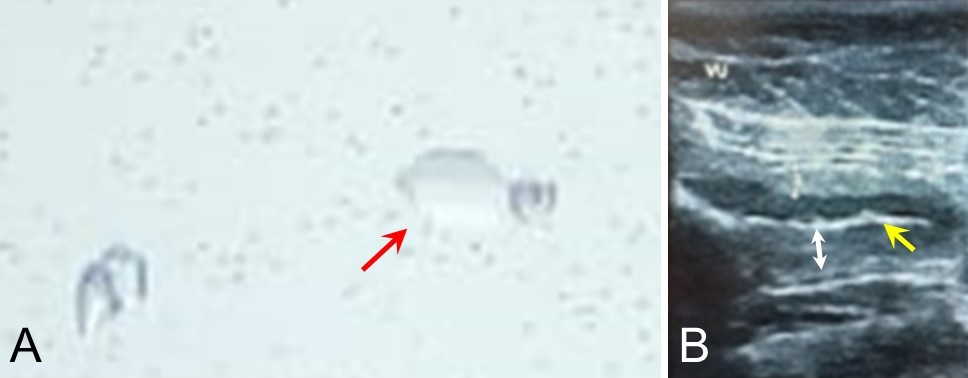Feline lower urinary tract disease diagnosis in an obese sterile male Persian mixed-breed cat
Abstract
Feline lower urinary tract disease (FLUTD) occurs because of dysfunction of the urinary bladder and urethra in cats. This study reported that FLUTD occurs in a castrated and obese male cat. The supporting diagnostics used to confirm the diagnosis are the dipstick test, urine microscopic observation, and ultrasound. The examination results showed pyuria, proteinuria, haematuria, struvite crystals, and cystitis. The pathophysiology of FLUTD in this case begins with the condition of castrated males, who tend to have little activity and become obese. Obesity increases the risk of ascending infections, which is one of the causes of crystal formation in the urinary tract.
Downloads
References
Apritya D, Yunani R, Widyawati R. 2017. Analisis urin kasus urolithiasis pada kucing tahun 2017 di Surabaya. Agrovet. 6(1):82-84.
Clarkson MR, Magee CN, Brenner BM. 2011. Chapter 2 - Laboratory assessment of kidney disease in Pocket Companion to Brenner and Rector's The Kidney. Ed 8. Missouri (US): W.B. Saunders. pp:21-41. https://doi.org/10.1016/B978-1-4160-6640-8.00002-6
Dorsch R, Teichmann-Knorrn S, Sjetne Lund H. 2019. Urinary tract infection and subclinical bacteriuria in cats: A clinical update. Journal of Feline Medicine and Surgery. 21(11):1023-1038. https://doi.org/10.1177/1098612X19880435 | PMid:31601143 PMCid:PMC6826873
Fauziah H. 2015. Gambaran cystitis melalui pemeriksaan klinis dan laboratoris (uji dipstik dan sedimentasi urin) pada kucing di klinik hewan Makassar. [skripsi]. Makassar (ID): FK UNHAS.
Harley L, Langston C. 2012. Proteinuria in dogs and cats. The Canadian Veterinary Journal. 53(6):631-638.
Hostutler RA, Chew DJ, DiBartola SP. 2005. Recent concepts in feline lower urinary tract disease. Veterinary Clinics: Small Animal Practice. 35(1):147-170. https://doi.org/10.1016/j.cvsm.2004.08.006 | PMid:15627632
Kovarikova S, Simerdova V, Bilek M, Honzak D, Palus V, Marsalek P. 2020. Clinicopathological characteristics of cats with signs of feline lower urinary tract disease in the Czech Republic. Veterinární Medicína. 65(3):123-133. https://doi.org/10.17221/146/2019-VETMED
Men YV, Arjentina IP. 2018. Laporan kasus: Urolithiasis pada anjing mix Rottweiller. Indonesia Medicus Veterinus. 7(3):211-218. https://doi.org/10.19087/imv.2018.7.3.210
Piyarungsri K, Tangtrongsup S, Thitaram N, Lekklar P, Kittinun-tasilp A. 2020. Prevalence and risk factors of feline lower urinary tract disease in Chiang Mai, Thailand. Scientific Reports. 10(1):196. https://doi.org/10.1038/s41598-019-56968-w | PMid:31932653 PMCid:PMC6957472
Plumeriastuti H, Novitasari SP, Arimbi A, Yunita MN, Hamid IS, Wibawati PA. 2023. Risk factors and incidence of feline lower urinary tract disease (FLUTD) in Sahabat Satwa Genteng Animal Clinic. Jurnal Medik Veteriner. 6(1):15-20. https://doi.org/10.20473/jmv.vol6.iss1.2023.15-20
Pusoonthornthum R, Pusoonthornthum P, Osborne CA. 2012. Risk factors for feline lower urinary tract diseases in Thailand. Thai Journal of Veterinary Medicine. 42(4):517-522. https://doi.org/10.56808/2985-1130.2432
Rizzi TE. 2014. Urinalysis in Companion Animal Part 2: Evaluation of Urine Chemistry and Sediment. available at https://www.todaysveterinarypractice.com.
Thomas G. Nyland, William R. Widmer, John S. Mattoon. 2015.Chapter 16 - Urinary Tract in Small Animal Diagnostic Ultrasound. Ed ke-3. Matton JS, Nyland TG (ed). Missouri (US): W.B. Saunders. https://doi.org/10.1016/B978-1-4160-4867-1.00016-7
Wael MK. 2012. Clinical survey and selection of therapeutic approach for emergent feline urological syndrome. Life Science Journal. 110(9):151-156.
Yadav SN, Ahmed N, Nath AJ, Mahanta D, Kalita MK. 2020. Urinalysis in dog and cat: A review. Veterinary World. 13(10):2133-2141. https://doi.org/10.14202/vetworld.2020.2133-2141 | PMid:33281347 PMCid:PMC7704312

Copyright (c) 2024 CC BY-SA

This work is licensed under a Creative Commons Attribution-ShareAlike 4.0 International License.
Authors who publish with this journal agree to the following terms:
1. Authors retain copyright and grant the journal right of first publication with the work simultaneously licensed under a Creative Commons Attribution License that allows others to share the work with an acknowledgement of the work's authorship and initial publication in this journal.
2. Authors are able to enter into separate, additional contractual arrangements for the non-exclusive distribution of the journal's published version of the work (e.g., post it to an institutional repository or publish it in a book), with an acknowledgement of its initial publication in this journal.
3. Authors are permitted and encouraged to post their work online (e.g., in institutional repositories or on their website) prior to and during the submission process, as it can lead to productive exchanges, as well as earlier and greater citation of published work (See The Effect of Open Access).

.jpg)















